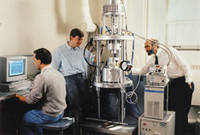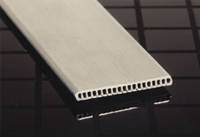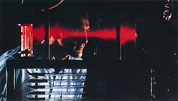
Air Conditioning and Refrigeration Center (ACRC)
University of Illinois at Urbana-Champaign
A National Science Foundation Industry/University Cooperative Research Center since 1988
Environmental concerns are driving the development of new coolant technologies

|
Center Mission and Rationale
The Air Conditioning and Refrigeration Center (ACRC) has two major goals: first, to contribute technology toward the development of energy-efficient equipment that uses ozone-safe refrigerants; and, second, to provide a forum for manufacturers to coordinate research and share results at the precompetitive stage.
The Center was founded in 1988 with a grant from the estate of Richard W. Kritzer, son of the founder of Peerless of America, Inc. ACRC currently receives support from more than 20 industrial sponsors, the Richard W. Kritzer Endowment, and the National Science Foundation.

|
Research Program
More than a dozen faculty members are involved in ACRC's research program. The systems under study include domestic refrigerators, mobile and stationary air conditioning systems, and commercial and industrial refrigeration. Related topics include:
- Properties - Refrigerant-lubricant mixtures and refrigerant blends
- Processes - Local heat transfer and pressure drop, frosting, controls, tribology, and oil circulation
- Components - Evaporators, condensers, expansion devices, and compressors.
The ACRC research program involves more than 40 graduate students and 30 undergraduates. Students are attracted by the opportunity to participate in industrially relevant research. Many of the Center's students are hired upon graduation by ACRC's industrial sponsors.

|
Special Center Activities
The Center communicates detailed research results to its industrial sponsors via the ACRC Technical Reports series. A typical research project yields one to three ACRC technical reports per year, plus occasional technical memoranda and other reports to sponsors.
The ACRC's modern equipment and facilities include:
- Flow visualization facilities for refrigerant/oil and air-side
- Condensation and evaporation loops - Determines local heat transfer and pressure drop in test sections of 1m, 3m, and 6m length. Refrigerant-lubricant mixtures and refrigerant blends are tested with smooth-and enhanced-surface tubes and microchannel extrusions
- Noise and vibration facilities - Air-side measurements in anechoic chamber, and refrigerant flow noise and component vibration experiments in dedicated facilities
- Falling-film wind tunnel - Provides realistic environment with vapor flow over falling-film evaporator or condenser tubes to determine falling-film mode transitions and local heat transfer
- Evaporator and condenser wind tunnels - Provide measurements of air-side, thermal-hydraulic behavior over a wide range of velocity, temperature, and humidity, and include quantitative measurement of condensation and frosting behavior
- Mass transfer wind tunnels - Allow local convective heat transfer studies in complex, compact heat exchanger geometries using an optical adaptation of the naphthalene sublimation technique
- Orifice and capillary tube facilities - Specialized test loops support investigations of suction-line heat exchangers and expansion device performance
- Environmental chambers - Capable of subjecting air conditioners and refrigerators to temperature and humidity conditions far outside the range of standard rating conditions. Equipped for component calorimetry using three independent measurements
- Mobile and stationary air conditioning test facilities - Dedicated breadboard systems support studies of transient performance and system control strategies.
Some of the Center's accomplishments include:
- Developing optical devices for online measurement of oil concentration in air conditioning and refrigeration systems, and liquid film thickness in two-phase flows
- Making the first measurements of liquid refrigerant flows in distributors and at the exit of an evaporator, using a laser-doppler particle analyzer to measure droplet velocity and size distributions
- Demonstrating the feasibility of transcritical thermodynamic cycles for mobile and residential a/c applications, and exploring novel control strategies
- Designing and building a pressurized tribotester that provides a realistic test environment for evaluating friction and wear characteristics of compressor contact geometries, material pairs, and refrigerant-lubricant combinations
- Obtaining detailed understanding of refrigerator cabinet heat transfer: investigating conductive, convective, and radiative phenomena in the door seal area; and determining sensible and latent loading during door-opening transients.
Center Headquarters
Air Conditioning and Refrigeration Center
University of Illinois at Urbana-Champaign
Department of Mechanical and Industrial Engineering
1206 West Green Street
Urbana, IL 61801
Tel (217) 333-3115 * Fax (217) 333-1942
Homepage: acrc.me.uiuc.edu
Center Co-Director: Dr. Anthony Jacobi
a-jacobi@uiuc.edu
Center Co-Director: Dr. Pega Hrnjak
pega@uiuc.edu
Center Evaluator: Dr. Ron Beck
(810) 574-6228 * beckr@tacom.army.mil
NSF 01-168ff